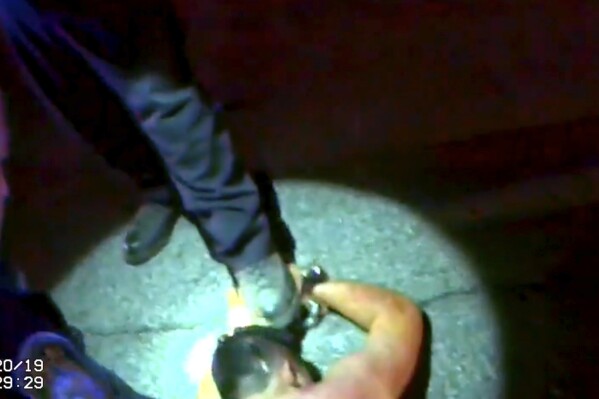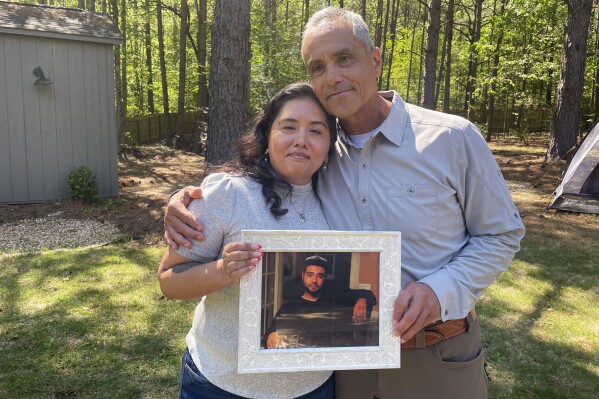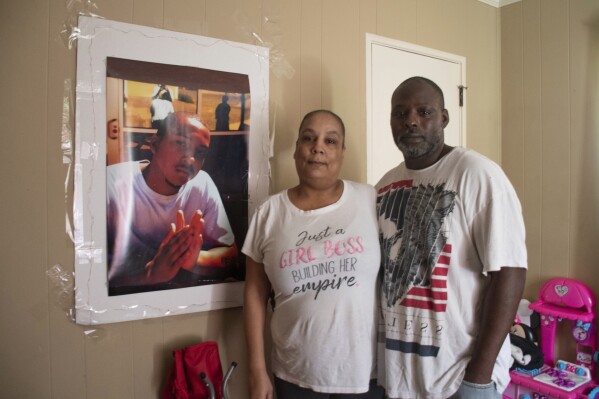Florida family’s 911 call to help loved one ends in death after police breach safety protocols
Joanne Celestin realized right away her brother was not himself.
Standing at the front door, he thought strangers were walking into the house he shared with his mom in their gated Florida neighborhood. He demanded Joanne hand over her keys so no one else could get inside.
“You are not Joanne,” he yelled after punching her in the face, sending her and her two children and mother hurrying to her Infiniti SUV.
After driving down the street lined with Mediterranean-style homes and palm trees, they called 911. Joanne told the dispatcher her brother had never hit them before. When the first officer arrived, she explained he had been diagnosed with schizophrenia and bipolar disorder.
As a nurse practitioner, she’d seen this play out before with others at the hospital. The police would bring her brother there for a mental health exam. He’d go to a treatment center. He’d be safe.
Instead, within 10 minutes, Samuel Celestin was near death. Officers shocked him with Tasers and pinned him facedown after he ran from the suburban Orlando home in Ocoee, on the edge of one of Florida’s wealthiest cities where celebrities like Tiger Woods have lived.



Five years later, his family blames police for ignoring their warnings and treating Celestin like a suspect instead of someone needing help. They believe he would’ve been handled with more patience and care were he not Black.
Celestin was among more than 1,000 people across the United States who died during a decade’s time after police used force that, unlike a gun, is supposed to stop but not kill, according to an investigation by The Associated Press in collaboration with FRONTLINE (PBS) and the Howard Centers for Investigative Journalism. In roughly 45% of the deaths, AP found, officers violated three or more guidelines for safely restraining people using what’s known as “less-lethal force,” including in Celestin’s case.
His death illustrates how decisions officers make before they use force can lead to a cascade of deadly consequences, even when families take care to emphasize their loved one was in a medical crisis. It also shows how police regularly face situations that can erupt unpredictably, especially with those in mental distress.
Mental distress calls can be complicated by people who are hallucinating and unable to understand commands. Policing leaders and other experts recommend officers remain calm, avoid making threats, be truthful and create space. While training has improved, many officers don’t get enough — or any at all.
That included the first officer who spoke with Celestin.
MENTAL HEALTH STRUGGLES
Celestin, the son of a lawyer and a doctor, immigrated to Miami from Haiti with his family at age 3. The youngest of four, he stood out early — sixth-grade class president, captain of the high school basketball team, Bible studies leader. He had a soft spot for those less fortunate, his family said, once as a teenager giving his bus fare to a homeless man even though it meant walking home from the movies.
His mental health struggles surfaced during his final year of high school, when he was diagnosed with anxiety. The medications left him lethargic, forcing him to give up an academic scholarship and drop out of Florida International University after one semester.
In the years that followed, he searched the internet for answers, using creams and prescribed injections, ordering herbal medicines, and reading neurological magazines. “He tried everything,” said his mother, Dr. Rose Celestin, who was a medical doctor in Haiti and worked as a physician’s assistant in the U.S.
Days before he died, Celestin, 33, became convinced the house’s tap water was poisoned and ordered the delivery of fresh gallons. He believed his mom was really someone else. Troubled, she moved toward getting him into treatment. She didn’t think he would go willingly.
On the night of April 11, 2019, he became more paranoid. Imagining that his phone had been sabotaged, he asked to see his mom’s phone. When she told him it was charging, he pushed her onto a sofa and punched her. That had never happened before.
“It was not Samuel. Samuel won’t hit me. It was a mental health crisis I was in front of,” she recounted.
Minutes later Celestin’s sister Joanne knocked on the door. After he punched her too, both women fled and waited at the community’s entrance, where they met Officer Joshua Bode of the Ocoee Police Department. They told him they were OK and didn’t want to press charges. Joanne explained how the family in 2013 arranged for an intervention unit to take him for treatment.
“Yeah, that’s kind of separate from us,” Bode told her. “I want to try to make contact with him sooner rather than later.”
At the time, Bode had no training in crisis intervention, which wasn’t mandatory, and didn’t receive any until four months after encountering Celestin. He later explained that he wanted to move quickly because he considered Celestin a danger and the family’s elderly aunt was still in the house, unharmed in her locked room upstairs.
The dispatcher had signaled it was a domestic disturbance involving mental illness, but Bode didn’t ask the family about Celestin’s behavior or medical history as best practices suggest, body-worn cameras showed.
Instead, he wanted to know who was hit and whether Celestin had ever been violent toward police.
‘NOT GOING TO PLAY THIS GAME’
As Bode approached the home, Officer Christopher Bonner joined him. Bonner later said he had 40 hours of crisis intervention training eight years before the Celestin call. Bode, however, didn’t talk with him about Celestin’s mental condition, according to the officers’ body cameras.
The pair, illuminated by a porchlight, knocked on the glass front door. Celestin partially opened it, appearing agitated and confused.
“Are you a real cop,” he asked. “Can I see your certification?”
“Yeah, let me just pull it out of my pocket right now,” said Bode, sarcastically.
“We’re not going to play this game,” Bonner said. “We’re here because someone said that you battered them. It’s simple as that.”
When Celestin insisted the officers call a detective, Bonner had enough: “Where’d you get your law degree?” he said.
Both officers later testified during depositions in response to a family lawsuit that they did not believe they were dealing with someone who was mentally ill, but rather someone challenging their authority – specifically, a “sovereign citizen” who doesn’t believe in the government’s legitimacy.
“I viewed it as he was trying to be argumentative and dismiss our authority,” Bode said.
Celestin shut the door then reopened it quickly.
“Get back,” Bonner told him three times, pushing his way through. He later said he didn’t yet notice that Celestin had a 10-inch knife, only seeing a TV remote control in his right hand.
“I’ll talk, I’ll talk,” Celestin said while backing into the house.
Bode spotted the knife, drew his Taser and fired. He later said he did so because the knife was so close. Body-camera video showed Celestin never lunged or swung the knife.
The first blast of darts hit Celestin’s chest but didn’t seem to affect him. Celestin, knife in hand, shoved Bonner as he ran out the doorway. The officer briefly lost his balance before firing a second set of darts into Celestin’s back. The jolt of electricity caused him to fall onto the porch and drop the knife.
Celestin slumped with his back against a porch column, arms extended outward, yelling, “I’ll stop. I’ll stop.” The two officers repeatedly hollered at him to get on his stomach — 23 times in little over a minute.
“You are about to get shot,” Bode screamed.
Bode and Bonner wouldn’t talk to AP. But in sworn depositions they said Celestin’s violent behavior forced their hand — extenuating circumstances that may excuse officers under safety practices.
Amy Watson, a professor at Wayne State University who has worked with agencies nationwide on crisis intervention, told AP after reviewing the video that the officers missed a chance to de-escalate the situation. She said they should have acknowledged Celestin’s state of mind, spoken calmly to him and avoided further agitating him.
“They approached him as a criminal and took his questioning as an insult, as opposed to stepping back and thinking, this guy is having a mental health crisis,” she said. “Screaming at him wasn’t going to get him to do what they wanted to do.”
FORCE OUTSIDE BEST PRACTICES
As the officers yelled during that minute on the porch, Celestin put his hands in front of his face, then on top of his head, covering his ears. He put his wrists together toward Bonner, telling him, “Sir, I’m sorry, arrest me.”
He pleaded with the officers, who made no move to handcuff him. “I didn’t attack you,” Celestin said, before springing to his feet and running down his driveway. Across the street, a backup officer from the neighboring city of Windermere tackled him.
Four officers grabbed Celestin, holding him down as he resisted their handcuffing attempts. One stunned Celestin three times in the back with a Taser, two shots coming in quick succession and lasting 19 seconds.
Records and video showed that the officers violated best safety practices in how they used their Tasers. They fired as many as 10 times and at least five of those connected, delivering electricity over the 15-second cap that law enforcement and medical groups advise against exceeding. They also at times didn’t give him warnings before he was shocked or pause between shots so that he had time to give up.
Once Celestin was handcuffed in just under a minute, he remained facedown in the grass for almost three minutes more. One officer pushed down on his upper back with a baton while others attached a restraint around his feet and wrists to immobilize him. They then stood by until they realized he was no longer breathing.
All of this was done despite long-standing warnings within policing about the dangers of compressing the lungs and heart during what is known as prone restraint, a risk compounded by the fact that, at 258 pounds, Celestin was clearly obese.
Bonner later defended the use of force, saying exigent circumstances allowed the officers to go beyond policy guidelines for using Tasers and prone restraint because Celestin posed a threat.
“We had followed policy and did everything by the book,” Bonner said.
THE AFTERMATH
Weeks later, the regional medical examiner classified Celestin’s death as a homicide, concluding he had experienced sudden cardiac arrest while restrained by law enforcement. But the medical examiner also stressed the homicide ruling didn’t imply criminal culpability.
Assessing that was the job of the state attorney’s office in Orlando. After a review, prosecutors decided there was no legal basis for charges. The next year, a newly elected prosecutor opted against reopening the case, saying that, although Celestin’s death was unjust and his treatment unacceptable, the officers had reason to take him into custody.
Inside their departments, no officer faced discipline. Ocoee police declined to comment to AP, saying the case had been through the court system. Windermere Police Chief David Ogden said the department’s officer didn’t violate any policies or procedures and that outside reviews also cleared him.
The Celestins turned to the courts by filing a civil lawsuit — and to the court of public opinion by holding rallies and teaming with a social justice group to draw attention to the case.
Nationally known experts hired by the family challenged the police’s version of events. A former police chief disagreed that Celestin fueled what happened, as one of the officers’ experts contended, and cited missteps by police from beginning to end — from failing to recognize Celestin needed mental help to not turning him to his side after he was handcuffed facedown.
Before the case reached a jury, the cities of Ocoee and Windermere agreed to a $1.5 million settlement with the family — money, they said, that meant little more than a symbolic acknowledgement of their loss.
Today, they remain frustrated no one has been held accountable and that his death did not become a nationwide flash point that pushed law enforcement to change how it handles those with mental illness. Still, they keep faith that Samuel Celestin will not be a nameless, faceless person who died after an encounter with police.
“As crazy as it sounds,” said Jean M. Celestin, one of two older brothers, “we’re still hoping for justice, as rare as it might be.”
___
Editor’s note: The information in this story is based on audio of the 911 call; video from the officers’ body-worn cameras; depositions with the officers and Celestin’s family; interviews with the family; expert reports filed in the lawsuit; policing best practices guidelines; and police, prosecutor and autopsy reports.
___
This story is part of an ongoing investigation led by The Associated Press in collaboration with the Howard Center for Investigative Journalism programs and FRONTLINE (PBS). The investigation includes the Lethal Restraint interactive story, database and the film “Documenting Police Use Of Force,” which premiered April 30 on PBS and is available online.
___
The Associated Press receives support from the Public Welfare Foundation for reporting focused on criminal justice. This story also was supported by Columbia University’s Ira A. Lipman Center for Journalism and Civil and Human Rights in conjunction with Arnold Ventures. The AP is solely responsible for all content.
___
Contact AP’s global investigative team at [email protected] or https://www.ap.org/tips
Disclaimer: The copyright of this article belongs to the original author. Reposting this article is solely for the purpose of information dissemination and does not constitute any investment advice. If there is any infringement, please contact us immediately. We will make corrections or deletions as necessary. Thank you.






